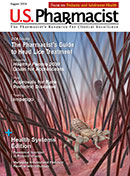

Polar Process
A look at how prescription polarized lenses are made
by John Young
Last month, we looked at how polarized lenses work. Now, you may wonder, how are these products manufactured? Because a step-by-step rundown of the manufacturing process would probably put an insomniac to sleep, I promise to keep this brief. But, understanding how polarized lenses are made also helps to better understand how they work.
The Earl of Sandwich would have loved the polarization process because that’s exactly what a polarized lens is—a sandwich. The “meat” layer, if you will, is Polyvinyl Acetate or “PVA.” This material has, roughly speaking, the consistency and thickness of Saran Wrap. To polarize a lens, PVA is first heated and then stretched to five times its natural length, making it even thinner. Manufacturers do this to lengthen the long chains of molecules making up PVA.

As you’ll recall from last month’s column, this glare component of light causes visual discomfort because it is disproportionate to light’s vertical component when reflected off most surfaces. While the surface of a material will absorb a good share of the vertical component, it is the reflected horizontal component that must be absorbed by the polarized lens to once again balance the two components of reflected light.
Once the PVA is dyed and dried it becomes very delicate to handle. For this reason it is “sandwiched” between two pieces of Cellulose Acetate Butyrate (“CAB”) to create what you see in the thin plano versions of most polarized sunglasses.
For more expensive sunglasses—as well as prescription lenses—the process differs only slightly. The thin sheet of dyed PVA is mounted to one sheet of CAB and then inserted into the mold of what will become a hard-resin lens. This is called the “embedded” process. There are also methods of creating a sandwich between two pieces of hard-resin or polycarbonate material. Either way, the result is a polarized lens.
In both methods, the PVA material is positioned very close to the front curve of the lens. This is primarily so the back curve can be surfaced without removing any PVA material. But there is also a secondary reason. We’ve all seen unusual patterns in the rear windows of a car or when viewing transparent plastic of any kind when wearing polarized lenses. The unusual patterns are caused by “stress” in the materials being viewed that polarized lenses allow you to see. If the PVA was located at the rear surface of a polarized lens (assumes some thickness to the lenses) we would likely see the stress pattern in the lens material we were wearing. Of course, that would create a distraction to normal viewing.
The polarizing process briefly summarized above works very well and brings comfort to wearers around the world. Today’s products have also benefited from the advancement of technology that allows other lens treatments to further enhance these lenses—including mirror and anti-reflective coatings. All work ultimately to improve wearer comfort.
John Young is an ophthalmic lens expert with more than 25 years experience in the optical industry. He has worked for several lens manufacturers, including American Optical and Essilor, and is the former technical director of the Optical Industry Association. His company, COLTS Laboratories, is a Clearwater, Fla.-based independent lens testing facility designed to provide thorough and accurate quality and performance evaluations of spectacle lens products. His clients include lens manufacturers, wholesale labs, independent research organizations, large retailers and independent dispensers. The lab was the first U.S.—ophthalmic testing laboratory—accredited by the American Association for Laboratory Accreditation. It is also a Safety Equipment Institute-accredited eye protection/safety test lab. Young can be reached by phone at (727) 725-2323 and by email at john@colts-laboratories.com.






